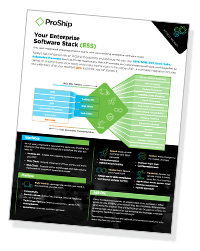Shelves are Overflowing: Why Parcel Shipping Software is the Key

How can retailers use shipping software to keep inventory moving?
After several pandemic-fueled years of using words like shortage, deficiency, and scarcity, headlines are now using words like abundance, excess, and surplus.
- Too Much Of A Goods Thing: Retailers Are Drowning In Inventory
- Target, Walmart, and Costco are stuck with way too much inventory — and the fix is trickier than just putting everything on sale
- Retail markdowns could be coming as companies tackle excess inventory
- Bloated inventories hit Walmart, Target and other retailers’ profits, trucking demand
- U.S. retailers' ballooning inventories set stage for deep discounts
Large retailers are stuck with too much inventory. The cause? When retailers saw supply chain disruptions triggering issues late last year, they stocked up. At that time, this strategy was wise, as capacity was expected to be limited and demand was still riding the pandemic-induced high. But now, with consumers spending more on services, like going out to eat, and less on big-ticket items, like appliances and furniture, retailers have an overabundance of these items. Not only are these products more expensive, but they are more expensive to store.
The best strategy for retailers? Keep inventory flowing.
While markdowns are likely, there is one giant piece of the puzzle that can keep the wheels of the supply chain greased so it can function efficiently within these retail organizations: multi-carrier shipping software. Multi-carrier shipping software can help these organizations ship these high volumes of parcels as they try to work through their inventory backlog.
How can parcel shipping software help with inventory management?
One of the main things that can help retailers unload some of this inventory is good data on what they already have. An Enterprise Software Stack (ESS) that is well-integrated can automate and optimize the way that information flows throughout the OMS, WMS, ERP, Ecom Suite, and any other Automated Processes. With packages shipping from a multitude of inventory locations and channels, an interface that is flexible will execute shipments as needed, whether that is in offices, stores, warehouses, etc.
Josh Mayer, Managing Partner at Summit Advisory Team and Co-Founder of Elevate, says that parcel shipping software can be used in three different areas of the customer journey to help identify the inventory selected for order fulfillment. Mayer states,
"The three areas where shipping software helps identify the right inventory location are the customer purchase process, the order sourcing and routing process, and at the time of shipment. During the customer purchase process, the software can be connected to the website (or any other order capture source) to define the total cost of fulfillment incorporating margin, labor, and shipping costs and select the best inventory/location based on business rules. After an order is placed, the software can send similar cost and service level data to the OMS. A modern-day OMS will combine that data with real-time inventory and capacity statistics to select the optimal location for order fulfillment. Lastly, at the time of packing an order, the shipping software can communicate with an OMS or WMS and leverage actual package weight, dimensions, and delivery expectations to select the best shipping service for delivery.”
A closer look at how multi-carrier shipping software works
It's not just the workflow that will benefit from multi-carrier shipping software, it’s in the name itself – multi-carrier. With access to carriers and services from around the globe, brands can meet customer delivery expectations while effectively managing transportation costs. They will see 3 palpable benefits in their supply chain: speed, precision, and flexibility.
Speed
As consumer and labor demands evolve, an elite multi-carrier shipping software can level-up the Customer Experience (CX) by supercharging processing speed and keeping delivery speed promises. With brands hoping to cycle thousands of packages through their shipping program each day, a robust and advanced software solution is a requirement. [Why You Need a Processing Speed That’s Fast and Furious] A system with high-performing technology can handle unlimited shipping requests from unlimited locations with the real-time processing of complex business rules and shipping logic.
The flipside of this coin is delivery speed. A shipping solution that utilizes advanced rate shopping and can facilitate omnichannel fulfillment initiatives will offer consumers shorter delivery times. Rate shopping allows retailers to optimize delivery information from carriers to provide an on-time delivery while saving on delivery costs and effectively shaving money from their bottom line. Bringing inventory closer to the consumer with an omnichannel fulfillment strategy will reduce time in transit and get the shipment on the end user’s doorstep faster. [The Key to True Omnichannel Integration]
Precision
Using inventory data and technology that synchronize with a multi-carrier shipping software will allow for streamlined shipment processing with precision. When brands are overloaded with products, accurate and complete orders become that much more difficult. Shipping software facilitates control of a retailer’s supply chain structure and can adapt the business logic and rules exactly as needed – and without the labor and time requirement of a software engineer. When a system utilizes database driven business rules, they can be modified without having to go into the code. [Learn more about Business Rules]
In addition to technical precision, a multi-carrier shipping software that ensures up-to-date compliance and compatibility is the gold standard and will safeguard accurate and complete shipments. While compliance is two-fold [Want to know what the 2 parts of compliance are?], it is essential to avoid downtime, especially for those who manage a Dangerous Good shipping program. Hazmat shipments are difficult and one of the most heavily regulated packages to process. Because they are dangerous to handlers and the environment, there are many rules and regulations to ship them. Not to mention expensive – penalties for improper shipments can run up to hundreds of thousands of dollars. Hazmat excess inventory has its own risks, disposal of excess or expired stock can quickly increase management costs and environmental hazards.
Flexibility
It’s evident that being able to pivot with the changes in demand is vital for a brand to stay competitive. With new shipping services entering, leaving, and expanding in the parcel shipping space, it’s still hazy for which players will be in the market. [Explore this further: Cloudy with a Chance of… What is the Shipping Technology Outlook?] One thing that we can count on – those who have the flexibility to keep up with these changes will find success. With the ability to scale as business evolves and needs change, for example, when your brand finds too much inventory on your shelves, your multi-carrier solution can add business rules, carriers, or any complementary add-ons [Find out more about ProShip Software Add-on Solutions] nuanced to your unique business to make sure your transportation budget doesn’t balloon up from the disruptions.
Another way to prepare for whatever the future brings? Utilize the data you have to gather insight for what actions to take now. If you want to take this one step further, you can gain access to real-time, end-to-end visibility across your carrier network on all shipments from execution to post-carrier billing with a Transportation Business Intelligence system, like MyShipINFO. The reports and analytics available in MSI can help shippers optimize inventory by identifying cost-drivers and substandard inventory patterns such as: split orders (single orders fulfilled from multiple locations), order profitability (items that are more costly to ship than their associated revenue), or inventory placement (inventory positioning in a multichannel fulfillment network). Being able to make clear, data-driven decision will propel these brands ahead of the pack.
As peak season nears closer, retailers will need to be decide how they want to proceed with their inventory issues. If they have the right technology in place, they will be better prepared to keep inventory flowing and avoid a further loss of revenue in a precariously changing landscape. As e-commerce grows, a multi-carrier shipping software solution will be the key for acclimating to these changes.

Schedule a ProShip Discovery Call
Speak with one of our parcel shipping experts to see how ProShip can improve inventory management and beyond by integrating with the rest of your enterprise technology stack to deliver real results (and improve your bottom line).
